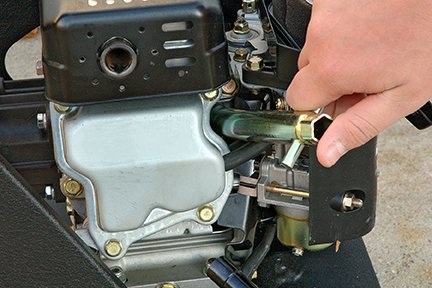Although your lawn and landscape equipment is built to last, everything wears out after a while and parts will need to be replaced. A simple preventative maintenance plan will extend the life of your equipment while saving time in the long run on repairs and replacements.
Plus, it’s easier than you think with our simple guides.
4 Pre-Use Checks
- Check the oil. This simple but often overlooked step can prevent a lot of headaches. Just be sure to wipe off the dipstick to prevent dust and dirt from entering the engine.
- Check the air filter. A clogged, wet or damaged air filter can lead to a loss of power, cause the engine to quit or allow dirt or water into sensitive areas.
- Check for leaks or damage. Do a quick once over of your equipment t make sure nothing looks wrong. This will keep you safe and prevent water from getting in the engine.
- Clean the engine. Use a non-petroleum-based degreaser to wipe away dirt and dust, rinse the engine down with warm water at low pressure, and then immediately dry the outside.
5 Regular-Use Checks
- Change the oil after 20 hours of use on a new engine and every 100 hours of use after that.
- Clean the air filter at least every 100 hours.
- To clean a foam filter, wash it with soapy water or a mixture of three parts kerosene and one part engine oil. Thoroughly rinse the filter,

Change the oil after 20 hours of use on a new engine and every 100 hours of use after that.
squeeze out excess water and blot dry. Then, work a small amount of engine oil into the foam filter and blot away any extra oil before placing it back in the engine.
- To clean a paper filter, tape it to a hard surface and gently knock away any trapped dirt and dust. Don’t use pressurized air or water. Replace after every 50 hours of use.
- Inspect spark plugs every 50 hours. Look for corrosion, damage or dirt, which can decrease power or lead to poor starting performance. Clean plugs with a wire brush or spark plug cleaner and replace damaged plugs.
- Clean and inspect the fuel strainer every month. If you notice sediment on the strainer, shut off the fuel-line valve, then remove, empty and clean the sediment bowl and filter screen. If sediment has gone into the tank, remove all of the fuel. Clean the residue from the sediment reservoir, which is the lowest point in the tank. Use a clean rag to wipe sediment from the filter element and the sides of the tank before refilling it with clean fuel.
- Check the fuel hoses annually. If the hoses are cracked, replace them.
Check out our YouTube channel and watch how to keep your small engine up and running.




